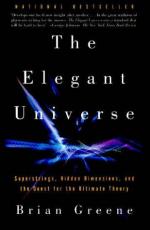
|
| Name: _________________________ | Period: ___________________ |
This test consists of 15 multiple choice questions and 5 short answer questions.
Multiple Choice Questions
1. Who provided the computer programming to process the results of the Morrison-Greene experiment?
(a) Rutherford.
(b) Tian.
(c) Aspinwall.
(d) Yau.
2. About how long after the big bang were stars formed?
(a) One billion years.
(b) One thousand years.
(c) 50 billion years.
(d) One hundred billion years.
3. Why are the extra dimensions needed in string theory?
(a) To remove time from its equations.
(b) To prevent the negative and infinite answers to its physical equations.
(c) To account for the infinite-energy problem.
(d) To provide more space for strings.
4. What is the traditional method of testing theories in physics?
(a) Consensus.
(b) Debate.
(c) Mathematical proof.
(d) Experimentation.
5. What did Stephen Hawking prove regarding black holes?
(a) Light cannot escape from them.
(b) The emit radiation.
(c) They have electrical charge.
(d) They are the most massive objects in the universe.
6. By what factor is the minimum mass of a wrapped string in determined?
(a) The vacuum energy of the dimension it is wrapped around.
(b) The size of the circular dimension it is wrapped around.
(c) The string's Planck tension.
(d) The string's winding number.
7. Which of the following is true regarding experimental evidence for super particles?
(a) They have been observed in multiple experiments.
(b) They have been observed for a long time, and have only recently been identified.
(c) They cannot be observed experimentally.
(d) They have not been observed.
8. How many family groups are the elementary particles divided into?
(a) Five.
(b) Two.
(c) Four.
(d) Three.
9. Which of the following best describes the fate of Kaluza-Klein theory?
(a) It became widespread for a short time, but receives almost no attention now.
(b) It was updated through the 1970s, and eventually incorporated into string theory.
(c) It became the mathematical basis of general relativity.
(d) It was quickly discarded as meaningless, but rediscovered by string theory.
10. What property of both black holes and elementary particles is still unknown?
(a) Their supersymmetric partners.
(b) Their relationships to strings.
(c) Their internal structures.
(d) Their spin.
11. When a black hole's entropy increases, which of its characteristics increases as well?
(a) Its spin.
(b) Its electrical charge.
(c) Its nuclear-weak force charge.
(d) The surface area of its event horizon.
12. What is M-theory?
(a) A specialized version of the "Heterotic A" string theory.
(b) A theory that would unite all branches of string theory.
(c) A combination of general relativity and string theory.
(d) An open-ended string theory.
13. Which of the following is true about the background microwave radiation of the universe?
(a) It is almost uniform, about 2.7 degrees Kelvin on average.
(b) It varies across the universe, and is no more than 12 degrees Kelvin anywhere.
(c) It varies across the universe, and is no more than 2.7 degrees Kelvin anywhere.
(d) It is almost uniform, and no more than 0.2 degrees Kelvin anywhere.
14. Which one of the following do physicists believe occurs at the central point of a black hole?
(a) An infinite-time flop-transition occurs.
(b) Space-time is torn.
(c) Space-time becomes inverted.
(d) A "white hole" is formed.
15. According to the standard model of the big bang, which of the following is true of the four fundamental forces during the first moments of the universe?
(a) They were not uniform throughout space.
(b) They were all melded together.
(c) They were divided into eight unidentified forces.
(d) They were "evaporated" in the high temperature, and didn't interact with space-time.
Short Answer Questions
1. In M-theory, what role does duality play?
2. Kaluza-Klein theory units which two fundamental forces?
3. What is the scientific state of the "multiverse" theory?
4. Why can the objects predicted by string theory not be observed?
5. What is a string's winding number?
|
This section contains 700 words (approx. 3 pages at 300 words per page) |

|




